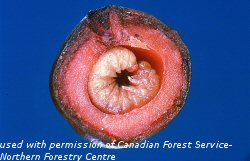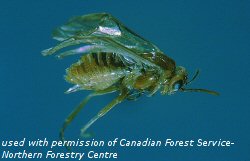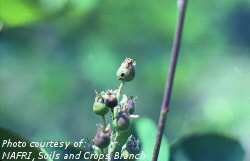Saskatoon Sawfly (Hoplocampa Montanicola)
Chokecherry Sawfly (Hoplocampa Lacteipennis)

Saskatoon sawfly scars from egg-laying

Sawfly larva within chokecherry

Sawfly adult

Saskatoon fruit infested with sawfly larva
Host Plants And Distribution
Saskatoon and chokecherry are hosts to both insects. Both insects are found throughout the Prairie Provinces and the bordering states.
Biology
Adults differ in colour, with the chokecherry sawfly being primarily yellow in colour and the saskatoon sawfly yellow with brown markings. Both species fly away when disturbed. Adults emerge in late May. Females lay their eggs in the nectaries of the blossoms of the host plants during flowering and petal drop. Egg laying sites are visible externally by a scar about 1-2 mm long on the calyx of the flower. Generally only a single egg is laid per flower and only one or two eggs per flower cluster. Eggs hatch 4 to 11 days after petal drop, and the larvae begin feeding at the top of the developing fruit. Larvae are yellowish-white in colour, possess legs, and may feed on more than one fruit, usually about 2 fruit per cluster. Larvae take about 45 days to complete development and are 6 mm long at maturity. At the end of June larvae drop out of the fruit, enter the soil and overwinter. Pupation occurs in the spring.
Symptoms And Damage
Small scars (2 mm) may be found on the upper part of the small green fruit, near the calyx. Larger fruit may have holes in the side of the fruit. Later, in June, the fruit may appear as empty, black shells. Infested fruit are difficult to pick or may lose their skin while the flesh remains attached. Fruit that are attacked drop off the plant resulting in decreased yield. Larval feeding can cause large numbers of immature fruit to drop. Losses from these insects can be quite extensive.
Scouting Techniques
Plants should be inspected for presence of adult sawflies from flower opening to 30 per cent petal drop. Additionally, fruit clusters should be inspected just before ripening for exit holes.
Economic Thresholds
There are no economic thresholds for adult sawflies. If the inspection during berry ripening indicates that the number of affected berries exceeds 10 per cent, control measures should be considered the following spring at 20 per cent bloom.

